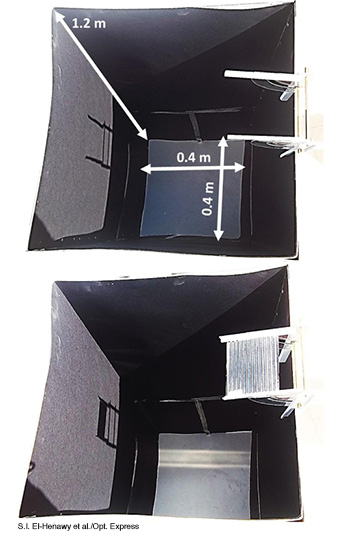
In the lab experiment, the "street" level deep well (top) is provided better illumination through the addition of a single panel (bottom).
Today’s dense urban areas often suffer from a chronic sunlight deficit, as tall, closely packed buildings crowd out the rays and leave much of the street below in perpetual shadow. A team of researchers in Cairo, Egypt, have proposed a novel and cost-effective solution: a simple, sinusoidal sheet of Plexiglas-like material that can be hung off of the tops of buildings and that casts sunlight down to brighten the dimly lit alleys below (Opt. Express DOI: 10.1364/OE.22.00A895).
The gloom of narrow streets in modern cities is more than a nuisance; it has, according to the new study’s corresponding author, Amr Safwat from Ain Shams University in Cairo, been tied to health problems such as depression, lethargy and sleep disorders. And, while a number of devices on the market can redirect light, they are designed mainly to provide shade or for indoor applications, not to steer scarce outdoor sunlight into the street below.
To bring sunlight back down to street level, Safwat and colleagues at Ain Shams and the American University in Cairo propose a new panel that would hang off of the roofs of buildings. The panel, fashioned from polymethyl methacrylate (PMMA), the raw material of Plexiglas, would have a corrugated, sinusoidal profile, and would refract sunlight into the street below in accord with Snell’s law. By tweaking the amplitude-to-period ratio of the sinusoidal function and the tilt angle of the panel off of the building top, the team was able to mathematically determine the design would transmit the greatest amount of light to the street below over the course of the year.
The team’s simulations suggest that the panels could boost street-level illumination by 200 to 400 percent in autumn and winter, the most light-starved periods. They’ve tested a small prototype in the lab, and the next step will be a full-scale model to be tested in a real alleyway. That test, if successful, could be followed by commercialization of the panels, expected to cost only $70 to $100 for a square-meter installation.
